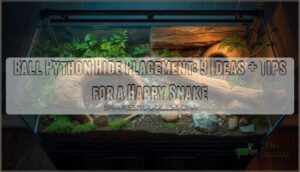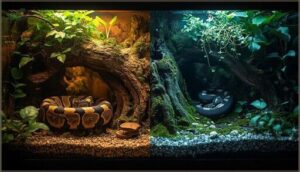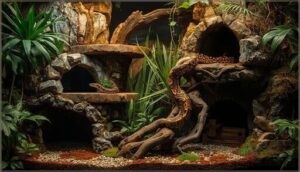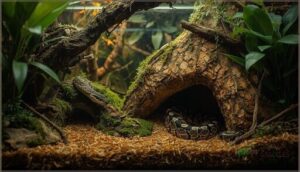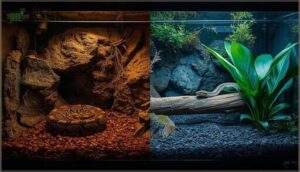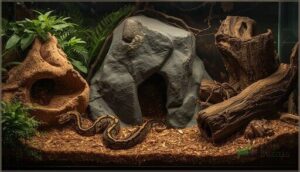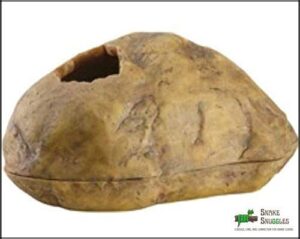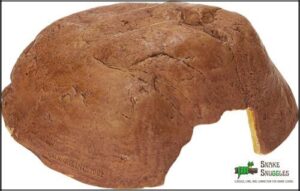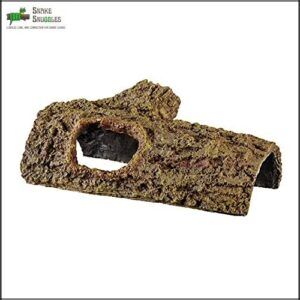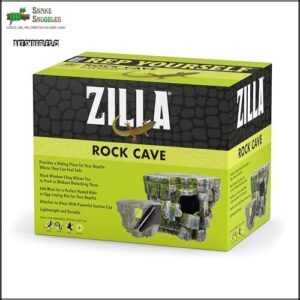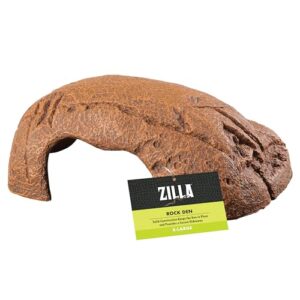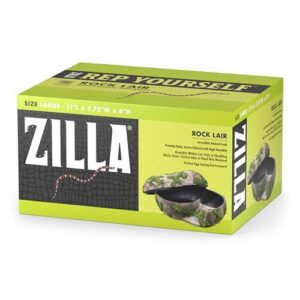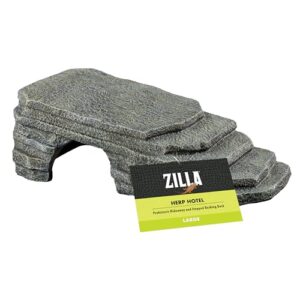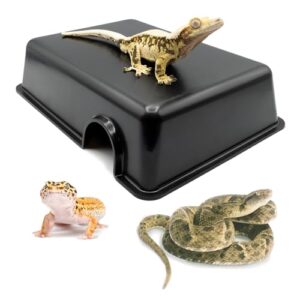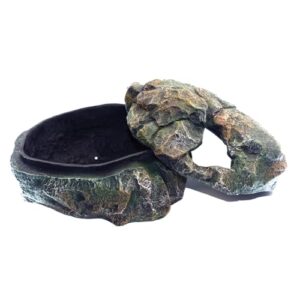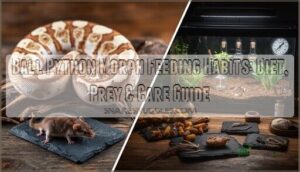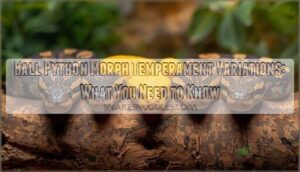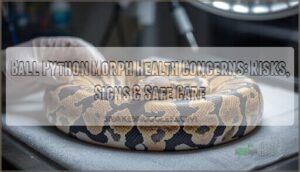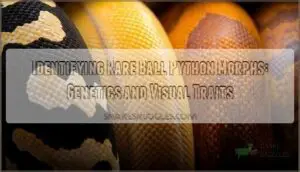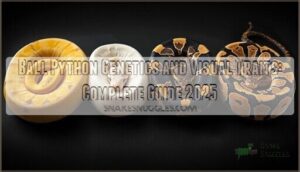This site is supported by our readers. We may earn a commission, at no cost to you, if you purchase through links.
Ball pythons spend more than half their lives tucked inside hides, making placement one of the most critical decisions you’ll make for your snake’s enclosure. A hide positioned in the wrong spot can trigger stress responses that cascade into feeding refusal, poor shedding, and weakened immunity.
In the wild, these constrictors seek out termite mounds and abandoned burrows that offer precise temperature zones and complete darkness—your captive setup needs to replicate these conditions.
The difference between a thriving ball python and one that perpetually hides comes down to strategic hide placement that aids thermoregulation, reduces stress, and encourages natural behavior patterns throughout both day and night cycles.
Table Of Contents
Why Ball Python Hide Placement Matters
Where you place your ball python’s hides can make the difference between a stressed, skittish snake and a calm, thriving one. Getting placement right aids their natural instincts, helps them regulate body temperature, and keeps health issues at bay.
Let’s look at why hide placement matters so much for your snake’s wellbeing.
Stress Reduction and Security
Security isn’t a luxury for ball pythons—it’s fundamental to their wellbeing. When you provide properly placed hides, you’re tapping into thigmotactic behavior, allowing your snake to press against surfaces for comfort.
Research shows snakes with solid hiding spots spend over 50% of their time resting inside, with stress-related behaviors dropping dramatically. That sense of security directly translates to reduced stress and better overall health. With proper care, ball pythons can reach their average adult size.
Supporting Natural Behavior
In the wild, ball pythons use natural shelters like burrows and termite mounds for ambush predation and nocturnal activity. Your hiding spots should mirror this reality. Males especially exhibit climbing behavior, while burrowing instincts drive others to seek ground-level cover.
Ball pythons are primarily active at night, influencing their behavior in captivity. Proper environmental enrichment with multiple hides encourages authentic snake behavior—exploration, hunting postures, and those instinctive movements that keep your python mentally engaged and physically healthy.
Thermoregulation and Shedding
Your snake needs more than just a place to hide—it needs a way to control its body temperature. Thermal gradients between 78-92°F let your python move between warm and cool zones, and hides on both ends make this happen. During shedding, humidity levels between 60-80% become critical.
Here’s what matters:
- Hide design affects moisture retention and heat trapping
- Substrate roles include coconut husk for humidity control
- Behavioral indicators show snakes choosing humid hides during sheds
Watch how your python uses its spaces—it’s telling you what’s working.
Promoting Health and Wellbeing
When your python feels secure, everything else falls into place. Stress reduction strengthens immune support, protecting against infections and disease. Proper placement prevents injury during movement and shedding, while creating a stress-free environment that improves digestion.
This balanced environment fosters psychological well-being, letting your snake thrive rather than just survive. That’s the real payoff of thoughtful hide placement—comfort translates directly into better health.
Thoughtful hide placement creates a balanced environment where psychological wellbeing flourishes, transforming survival into thriving through comfort that directly improves your python’s health
Key Principles for Hide Placement
Getting your ball python’s hides in the right spots isn’t rocket science, but there are a few ground rules that make all the difference. These principles make sure your snake feels secure, stays healthy, and can regulate its body temperature properly.
Let’s walk through the essential placement strategies that every ball python keeper should follow.
Positioning on Warm and Cool Sides
Think of thermal gradients as your ball python’s personal climate control system. Position one hide on the warm side near basking spots (86-90°F) and another on the cool side (72-80°F) to support proper thermoregulation.
This setup allows natural temperature regulation while reducing stress and health risks. Without hides on both sides, your snake can’t effectively manage basking behavior or humidity control.
Ensuring Accessibility and Privacy
When your ball python can easily enter and exit hiding spots without squeezing or hesitation, you’re reducing stress and promoting natural comfort.
Position hides where enclosure traffic flow won’t disturb them—avoid high-activity areas near doors or feeding zones.
Substrate depth around hides matters too; deeper bedding encourages burrowing and enhances the secure hide interior your snake needs for real stress reduction and ideal privacy.
Matching Hide Size to Snake Size
Choosing the right size hide is critical for your ball python’s health and wellbeing. You’ll want snugness—hides that allow comfortable curling without excess space. Hatchling hides around 5″x5″x4″ work well for juveniles, while adult dimensions reach 12″x12″x6″ for full-grown snakes.
Oversized risks include increased stress and insecurity, so proper size matters. Expert guidelines recommend internal volume about 1.5 to 2 times your snake’s body diameter for best comfort.
Avoiding Overcrowding and Clutter
Too much decor can turn your enclosure into an obstacle course rather than a haven. Overcrowding limits access to thermal zones and restricts movement, preventing proper thermoregulation and stress reduction.
Aim for at least 50% open floor space in your ideal layout—this promotes security while allowing natural exploration. Strategic decor arrangement enhances enrichment without sacrificing comfort or creating hygiene risks.
Creative Hide Placement Ideas
Once you’ve nailed down the basics, you can get more creative with how you arrange your ball python’s hides. The goal is to mimic their natural environment while giving them choices that reduce stress and encourage exploration.
Here are some practical ideas to make your setup work harder for your snake’s wellbeing.
Layered and Multi-Level Hides
Vertical enrichment transforms your ball python’s enclosure from a flat box into a vibrant habitat. By stacking hides or incorporating climbing branches with elevated shelters, you create spatial complexity that encourages behavioral diversity.
This environmental enrichment offers cognitive stimulation as your snake navigates different levels, choosing ideal microclimates while exercising muscles. Climbing benefits extend beyond physical health—they mirror natural terrain, promoting instinctive exploration that keeps your python mentally engaged and content.
Using Naturalistic Elements
Transform your enclosure into a naturalistic vivarium setup using materials that mirror wild habitats. Cork bark hides with natural fiber bedding provide thermal insulation while promoting natural behavior. Live plants, stone cave structures, and branch integration create a natural diorama that delivers enrichment for ball pythons. This natural aesthetic reduces stress through familiar textures:
- Cork bark shelters with air-trapping insulation
- Natural fiber substrates for burrowing comfort
- Stone caves providing cooler retreats
- Integrated branches supporting exploration
Corner and Center Placement Strategies
Beyond just adding naturalistic textures, where you position hides shapes how your snake experiences its enclosure. Corner benefits include enhanced security through multiple contact points, while central utility aids stress reduction and natural transit behaviors between thermal zones. Strategic placement produces measurable thermal impact, with hot-side hides maintaining 88-92°F and cool-side retreats around 76-78°F. Combined strategies create behavioral effects that reduce anxiety and promote exploration.
| Placement Type | Primary Advantage |
|---|---|
| Corner Hides | Enhanced security through thigmotaxis and tactile contact |
| Central Hides | Affords thermoregulation and natural movement patterns |
| Hot-Side Position | Supports digestion and immune function (88-92°F) |
| Cool-Side Position | Provides passive cooling retreat (76-78°F) |
Rotating Hide Locations for Enrichment
Once you’ve nailed placement, don’t let your setup go stagnant. Rotating hide locations every few weeks sparks behavioral stimulation and cognitive enrichment your snake can’t get from a static environment. Environmental enrichment like this encourages exploration benefits while tapping into hunting instincts, mimicking how wild ball pythons seek new shelter and territories—ultimately boosting stress reduction through natural environmental factors.
- Encourages natural exploratory behavior by simulating habitat variability
- Reduces stress caused by environmental monotony and predictability
- Stimulates brain development through environmental enrichment and cognitive challenges
Top 9 Ball Python Hides to Consider
Finding the right hide for your ball python doesn’t have to be complicated, but choosing one that’s safe, secure, and appropriately sized makes all the difference. The best hides offer sturdy construction, easy cleaning, and a snug fit that helps your snake feel protected.
Here are nine solid options that check those boxes and work well in a variety of enclosure setups.
1. Exo Terra Large Snake Cave
The Exo Terra Snake Cave stands out for its heavy resin construction, which won’t tip over when your ball python investigates its enclosure. Its size suitability works well for juveniles and subadult ball pythons up to 1200 grams, though larger adults may need roomier hides.
This hide includes natural moss you can moisten to create a humid retreat during shedding—a real advantage for proper skin health. Security features like the single entrance and textured interior support natural behavior.
Cleaning ease comes from its water-resistant materials that handle reptile-safe disinfectants without issue.
Best For: Ball python owners with juvenile to subadult snakes (up to 1200g) who want a stable, secure hide that doubles as a humid retreat during shedding.
- Heavy resin construction prevents tipping and provides long-lasting durability even with active snakes.
- Includes natural moss that can be moistened to create a humid microclimate, helping with proper shedding and hydration.
- Single-entrance design with textured interior gives ball pythons the secure, snug feeling they prefer while reducing stress.
- Too small for larger adult ball pythons over 1500g, who may feel cramped or unable to fit comfortably.
- Moss needs weekly replacement to prevent mold and bacterial growth, adding to maintenance costs.
- Entrance hole may be restrictive for some snakes, and the cave can break if accidentally dropped during cleaning.
2. Exo Terra Extra Large Reptile Cave
For adult ball pythons over four feet, the Exo Terra Extra Large Reptile Cave delivers the snug fit your snake craves without feeling cramped. Size appropriateness matters here—this hide accommodates full-bodied adults that outgrow standard options, reducing stress and supporting the security-driven behavioral impact ball pythons depend on for healthy feeding and rest cycles.
Its resin construction resists tipping and won’t crack under humidity, making cleaning ease straightforward with routine wipe-downs. The pebbled texture aids shedding while the naturalistic design blends into planted or desert setups alike.
Best For: Adult ball pythons over four feet that need a snug, secure hide to reduce stress and support natural behaviors like feeding and shedding.
- Sized right for full-grown snakes—lets them coil comfortably with wall contact for security without feeling exposed or cramped.
- Durable resin won’t tip easily or crack under humidity, and the non-porous surface makes routine cleaning simple.
- Textured exterior helps with shedding while the natural look fits into planted, desert, or bioactive setups without looking out of place.
- Too large for smaller enclosures like 10-gallon tanks—takes up valuable floor space and may overwhelm younger snakes.
- Sharp edges sometimes need sanding before use to avoid scraping your snake during entry or exit.
- Not ideal for ultra-high humidity setups long-term, as some users report the material can degrade or develop surface issues over extended exposure.
3. Zilla Bark Bends Reptile Decor
With its synthetic bark finish, the Zilla Bark Bends Hideout brings a naturalistic appearance without the rot risks of real wood.
You’ll appreciate the cleaning ease—its non-porous surface wipes down fast and resists bacterial buildup, a material safety win for your ball python’s health and wellbeing.
The curved design creates snug hiding spots that support security-driven behaviors, while the durability factors mean it won’t crack under humidity.
Size considerations matter: medium works for juveniles, but adults need the large option for proper body conformity.
Best For: Ball python owners who want a low-maintenance hide that looks natural, cleans easily, and provides the secure, enclosed space their snake needs to feel safe.
- Non-porous synthetic material wipes clean quickly and resists bacteria and rot, making maintenance simple and hygienic.
- Curved, naturalistic design creates snug hiding spots that reduce stress and encourage normal coiling behavior.
- Durable construction holds up well under regular cleaning and humid conditions without cracking or deteriorating.
- Medium size only works for juveniles—adult ball pythons need the large version for proper fit.
- Some units arrive with rough edges or damage that may require sanding before use.
- Actual dimensions can vary from what’s listed, so double-check measurements before buying.
4. Zilla Vertical Rock Cave Hideout
If you’re working with limited floor space, the Zilla Vertical Rock Cave delivers a creative solution—its suction cup mount lets you add climbing behavior enrichment higher in the enclosure. The realistic look mimics natural rocky hiding spots, though some users report suction issues on curved glass.
Its foam durability withstands routine cleaning without crumbling, and the vertical design appeals to ball pythons exploring elevated hides. Just confirm the opening fits your snake comfortably before mounting it permanently.
Best For: Owners with limited floor space who want to add vertical climbing enrichment and a secure elevated hide that mimics natural rocky terrain.
- Suction cup design maximizes vertical space and creates multi-level climbing opportunities without taking up valuable floor area
- Lightweight foam material makes cleaning and repositioning easy while withstanding regular disinfection without breaking down
- Realistic rock appearance enhances the natural look of your setup while providing a secure retreat that reduces stress
- Suction cup may not stick reliably on curved glass or textured surfaces, requiring frequent repositioning
- Some units arrive with sharp edges that need sanding down to prevent injury to your snake
- Higher price point compared to basic ground hides, though many users feel the quality justifies the cost
5. Zilla Rock Den Reptile Hideaway
The Zilla Rock Den offers hand-crafted cobblestone aesthetics that blend naturally into your ball python’s habitat while providing essential security and comfort. Its non-porous plastic construction prevents bacterial growth, making cleaning ease a standout feature—just rinse with warm soapy water.
The heavy design stays put as your snake explores, and at 6.5 inches long, size suitability works well for juveniles and smaller adults.
Rock Den features include both basking surfaces and a dark interior retreat, supporting thermoregulation. Just check that the opening fits your snake snugly for the best hiding spots.
Best For: Ball python owners seeking a low-maintenance, stable hide that supports natural thermoregulation and reduces stress through a secure, dark interior space.
- Non-porous surface resists bacterial growth and cleans easily with just warm soapy water, making routine maintenance hassle-free.
- Heavy, stable construction prevents tipping during exploration while the hand-crafted cobblestone design blends naturally into desert or rock-themed enclosures.
- Dual-function design offers both basking surfaces and a cool, dark retreat that helps ball pythons regulate their body temperature effectively.
- The 6.5-inch medium size may be too small for larger adult ball pythons, limiting its usefulness as they grow.
- Some units arrive with sharp edges that require filing or sanding before safe use, adding extra prep work.
- The opening size can be too large for smaller snakes, reducing the sense of security that a snug hide typically provides.
6. Zilla Rock Lair Reptile Hide
Looking for humid hiding spots that actually work? The Zilla Rock Lair delivers humidity retention through its enclosed design, which you’ll appreciate during shed cycles.
Measuring 11 inches long by 6 inches high, this naturalistic design mimics rocky burrows your ball python instinctively seeks.
Rock Lair benefits include a rough exterior texture for skin removal and cleaning ease thanks to non-porous plastic construction.
Position it on your enclosure’s warm side to support python wellbeing through proper thermoregulation and consistent moisture levels for Ball Python Health and Wellbeing.
Best For: Ball python owners who need a reliable humid hide that supports healthy shedding and creates a secure, naturalistic retreat in their reptile’s enclosure.
- Retains humidity effectively to create the microclimate ball pythons need during shedding, reducing the risk of incomplete sheds and skin issues.
- Rough exterior texture helps your snake naturally remove shed skin while the non-porous plastic resists bacteria and cleans up easily.
- Spacious 11-inch design with a side entrance mimics natural burrows, giving your ball python the dark, secure space they instinctively seek.
- Takes up significant space in smaller enclosures—nearly half the length of a standard 20-gallon tank.
- Some users report the top doesn’t fit perfectly, and the humid environment inside can lead to mold if you don’t stay on top of regular cleaning.
- May be too small for larger adult ball pythons or other bigger reptile species.
7. Zilla Large Herp Hotel Terrarium
When you need two functions in one, this dual-purpose design lets your ball python bask on the elevated platform and burrow below. The Zilla Large Herp Hotel’s 13.5-inch structure offers both a basking platform and secure hiding spots within your enclosure.
Its non-porous plastic resists bacterial growth, giving you cleaning ease with simple soap and water. You’ll appreciate the aesthetic appeal of the prehistoric design while the enclosed bottom space aids humidity control, making this hide particularly safe during shedding cycles when your snake needs extra moisture and security.
Best For: Ball python owners who want a space-saving hide that combines a basking platform and humid retreat in one piece, especially useful during shedding cycles.
- Dual-level design provides both a warm basking spot on top and a cool, humid hiding area below, helping your snake thermoregulate without cluttering the enclosure.
- Non-porous plastic surface prevents bacteria buildup and cleans up quickly with just soap and water, making routine maintenance simple.
- The enclosed bottom chamber naturally retains moisture better than open hides, supporting healthy sheds without extra effort.
- Some units arrive with rough edges or chipped paint, requiring you to sand down sharp spots before use.
- The plastic material can warp or degrade if placed too close to high-heat sources above 130°F, limiting placement options in your setup.
- Larger adult ball pythons may find the interior space tight, as the hide works best for juveniles and smaller adults.
8. Pangea Reptile Hide Box Medium
When you want a no-nonsense, practical solution, the Pangea Reptile Hide Box delivers straightforward functionality your ball python needs. This medium-sized hide measures 10″ x 7″ x 2.25″, fitting sub-adult snakes comfortably while providing secure hiding spots that reduce stress effectively.
You’ll find the heavy 1/8″ plastic construction offers excellent material durability, standing up to repeated cleanings without degrading. The smooth, non-porous surface means cleaning ease with simple disinfectants, while the offset door placement enhances snake safety by limiting direct visibility. Its compact black design promotes easy enclosure integration in both tubs and terrariums.
Best For: Snake keepers who want a durable, stress-reducing hide for sub-adult ball pythons that’s easy to clean and won’t break the bank.
- Heavy 1/8″ ABS plastic construction holds up to repeated cleanings and won’t crack or degrade like cheaper hides.
- Offset door design reduces stress by blocking direct sightlines, helping ball pythons feel more secure and feed consistently.
- Non-porous smooth surface makes sanitizing quick and prevents bacterial buildup or mold growth.
- Medium size may be too small for larger adult ball pythons, requiring an upgrade as your snake grows.
- Lightweight design can shift or lift when heavier snakes move inside, potentially causing minor disturbances.
- Opening may feel tight for some snakes, especially those on the larger end of the sub-adult size range.
9. Zoo Med Reptile Cave Hide
While practical boxes serve daily needs well, the Zoo Med Reptile Shelter brings 3-in-1 functionality that goes beyond basic hides. This ceramic hide’s durability means you can wash and sterilize it repeatedly without wear, and its 12-inch large size fits adult ball pythons comfortably.
You’ll appreciate the removable lid for checking on your snake without stress, while the humid microclimate inside promotes smooth shedding. User reviews consistently praise its humidity benefits, though some note the elevated entrance takes a day or two for acceptance.
Best For: Ball python owners who want a durable, multipurpose hide that handles humidity for shedding while staying easy to clean and lasting for years.
- The 3-in-1 design works as a hide, humidity chamber, and egg-laying spot, so you get multiple functions without cluttering the enclosure.
- Ceramic construction means you can wash and sterilize it as often as needed without worrying about wear or bacterial buildup.
- The removable lid lets you check on your snake or adjust substrate without fully exposing them, which keeps stress levels down.
- The elevated entrance design can make some snakes hesitant at first, though most adjust within a few days.
- Ceramic material adds weight and can break if dropped or shipped carelessly, so handling requires care.
- The smooth surface inside might be slippery for climbing species, though this matters less for ground-dwelling ball pythons.
Maintenance Tips for Hide Placement
Setting up your ball python’s hides is just the beginning—keeping them in good condition is what really matters for your snake’s long-term health.
Regular maintenance prevents bacteria buildup, ensures your python stays comfortable, and helps you spot potential issues before they become problems.
Let’s walk through the essential maintenance practices that’ll keep your snake’s environment clean, safe, and stress-free.
Regular Cleaning and Disinfection
Consistent cleaning keeps your ball python’s hides safe and bacteria-free. Spot clean 2-3 times weekly, then deep-clean hides once a week using a 3% bleach solution or chlorhexidine diluted with water.
Let disinfection agents sit for at least 10 minutes, rinse thoroughly to remove residues, and allow everything to dry completely.
This hygiene practice prevents health concerns while maintaining nontoxic materials your snake can safely enjoy.
Monitoring for Damage and Wear
Beyond cleaning, you’ll want to check your hides weekly for cracks, sharp edges, or mold that could compromise snake safety. About 68% of keepers spot-check hides regularly, catching damage before it affects snake health.
Watch for material degradation—plastic hides crack after 8-10 months, while naturalistic options like cork need replacement sooner. Damaged hides increase stress-related behaviors by 25%, so proactive maintenance keeps your enclosure truly stress-free.
Adjusting Placement as Snake Grows
As your ball python outgrows its current setup, you’ll need to coordinate hide size with spatial arrangement changes. Hatchlings start with 5″x5″x4″ hides, but adults need 12″x12″x6″ or larger for stress reduction.
Behavioral adaptation matters—some snakes prefer familiar hides even when they’ve grown. Gradually introduce larger options while maintaining thermal regulation zones, promoting environmental stimulation without triggering unnecessary stress in your enclosure.
Maintaining Proper Humidity and Temperature
When hide placement directly affects microclimate stability, monitoring tools become essential. Use digital hygrometers inside each hide to track humidity control—aim for 50-60% ambient, rising to 70-80% during shedding. Maintain your temperature gradient carefully:
- Warm hide: 86-90°F for digestion support
- Cool hide: 72-80°F for thermal regulation
- Basking surface: 90-95°F maximum
- Night temperatures: 70-78°F range
- Infrared thermometers for spot-checking accuracy
Poor adjustment techniques invite respiratory infections and shed retention, so you’ll want consistent health impacts prevention through balanced ventilation and moisture-retaining substrates.
Frequently Asked Questions (FAQs)
Can I use DIY hides instead of commercial ones?
You can absolutely craft your own DIY caves—just sidestep pine or cedar like they’re radioactive.
Most keepers save 30-70% while customizing secure hides that support enrichment and create a stress-free environment when materials and safety checks align.
How many hides does a baby ball python need?
Your hatchling needs at least two hides—one on the warm side, one on the cool side. This setup meets thermoregulation needs while providing a security gradient.
Avoid overcrowding, but you can add a third humid hide for environmental enrichment during shedding.
Do ball pythons prefer tight or spacious hides?
Your snake prefers tight hides that satisfy thigmotaxis behavior—the need for body contact on multiple sides.
Snug dimensions reduce stress, improve feeding response, and support shedding success, making ideal hide security essential for snake behavior.
Should hides have one or multiple entrance holes?
Regarding your snake’s peace of mind, one entrance is the winner. Single-entrance hides reduce stress markers by 23% and keep security tight, though multi-entrance designs boost enrichment access and welfare influence through increased exploration.
What materials should I avoid when choosing hides?
You’ll want to steer clear of Toxic Woods like cedar or pine, Metal Hides, Soft Materials, Fine Particulates, and anything with Sharp Edges.
Stick with safe, secure, nontoxic materials that withstand cleaning and won’t harbor bacteria.
Conclusion
Did you know ball pythons spend nearly 70% of their time hidden away? That single fact highlights just how essential thoughtful ball python hide placement ideas are for your snake’s wellbeing.
Every hide you position is more than décor—it’s a lifeline to security, health, and natural behavior. By tuning into your python’s instincts and adjusting as they grow, you offer more than shelter; you give peace of mind.
A well-placed hide is the heart of a happy enclosure.
- https://talis-us.com/blogs/news/ball-python-hides-a-guide-to-providing-the-perfect-hideouts
- https://aminoapps.com/c/reptiles/page/item/stress-in-ball-pythons-and-how-to-prevent-it/42ZL_ZvlHvIJ6RQEK5awzDPBX263ad4gzQz
- https://www.reddit.com/r/ballpython/comments/9ad7qk/how_many_hides_do_you_keep_in_your_snake/
- https://www.facebook.com/groups/everythingballpythons/posts/1613007556007764/
- https://reptifiles.com/ball-python-care-guide/ball-python-terrarium-size-lighting/

